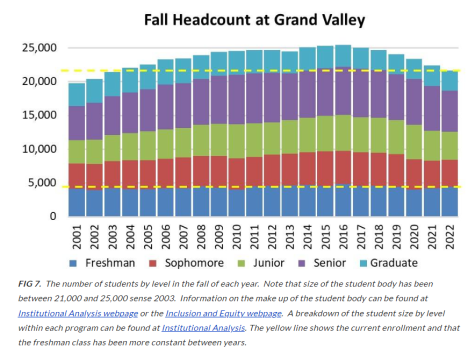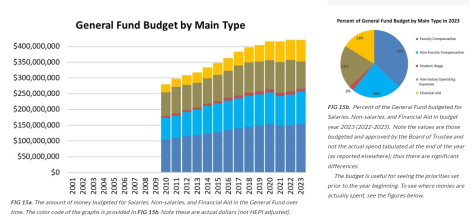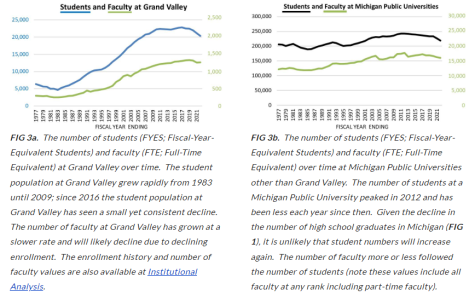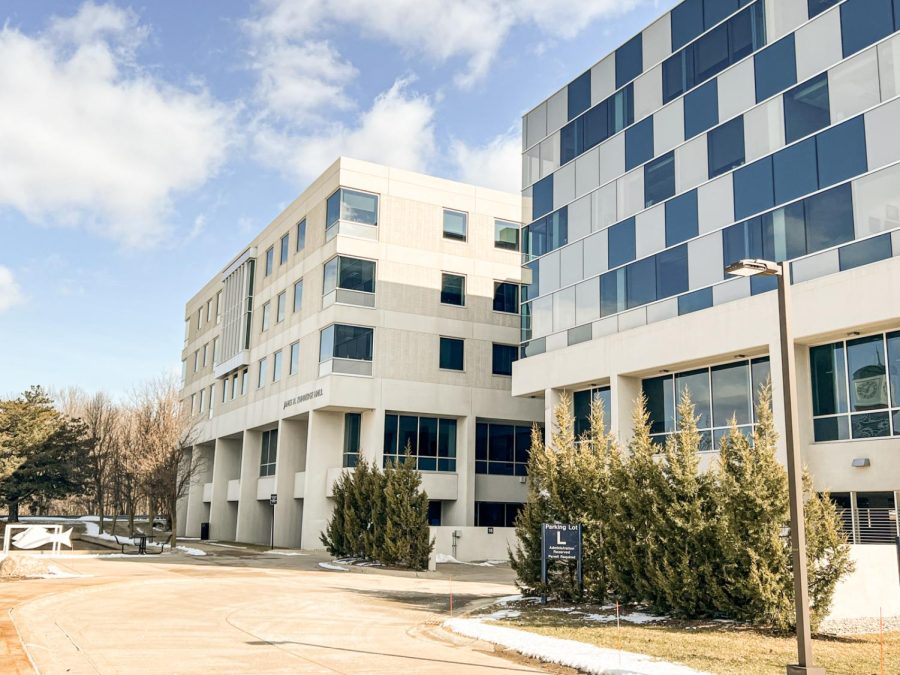AAUP hosts Understanding Faculty Salary Event
Jan 23, 2023
The advocacy chapter of the American Association for University Professors (AAUP) at Grand Valley State University hosted an event intended to promote transparency about faculty salaries at GVSU.
Founded in 1915, the AAUP is a national organization committed to promoting academic freedom, shared governance and the economic security of faculty and other academic professionals.
Each year, AAUP releases a report on the economic status of the profession. The 2020-21 report found that “real wages for full-time faculty decreased 0.4 percent, the first decrease since the Great Recession, after adjusting for inflation.”
The virtual Jan. 18 event put this data into context at GVSU.
Speakers at the event included Faculty Salary Budget Committee (FSBC) chair Bob Hollister, AAUP member and math professor Matt Boelkins, AAUP President Joel Stillerman and Young Democratic Socialist of America (YDSA) club President Foster Thorburn.
Hollister presented data collected by the university on faculty compensation. The FSBC is a standing subcommittee of the University Academic Senate that “advocates for the faculty on all matters with significant budgetary implications with focused attention on new programs, salaries and healthcare benefits,” according to the FSBC website.
Notably, Hollister pointed out that enrollment has declined over the past several years, putting pressure on the university’s general budget and making it difficult to increase faculty salaries.


“The budget is tight because enrollments are declining, and that makes it so it’s hard to increase salaries,” Hollister said during his presentation.
As enrollment has declined, data shows that the number of faculty at GVSU has remained relatively high.
“I’m always asked, ‘If you got a choice, would you have more faculty?’ My response is always that you have to pay the people that are here properly,” Hollister said. “You can’t just have more faculty, build new buildings, pay people more unless we increase tuition and time, but that’s not gonna happen. It’s a balancing game, but hopefully, the balance will continue to put faculty and – for that matter – students and staff, first.”

According to Boelkins’ presentation during the event, the average salaries for full, associate and assistant professors have increased “at respective rates of 19.7%, 23.1% and 35.1%” in the past 11 years. Additionally, faculty salaries were frozen between fall 2019 and fall 2021.
Boelkins compared this with salaries of the highest-paid university administrators, including the President, Provost, Vice Presidents and Deans, which increased at an average of 44% in the last 11 years.
Boelkins acknowledged that while faculty makes up a much larger population of GVSU employees than administrators, he’s concerned that administrative salaries have increased at a higher rate than faculty salaries, on average, over the past several years.
GVSU’s AAUP chapter was founded in 2020 in response to increased demands placed on faculty during the COVID-19 pandemic, Stillerman said. Since then, they have advocated for greater faculty voice and oversight and strategic planning, college reorganizations, Title IX processes, campus public health measures related to COVID and faculty salaries and workload.
“I and my colleagues feel that it’s been a very hard few years for faculty and for students,” Stillerman said. “While University officials have expressed gratitude verbally, we really don’t think like we’ve experienced that acknowledgment in terms of our salaries.”
During his portion of the presentation, Stillerman shared concerns regarding faculty morale, and how this could impact students as well.
“Faculty working conditions are student learning conditions,” Stillerman said.
Stillerman said both students and faculty share an interest in high-quality education. In the past, AAUP has partnered with GVSU’s Student Senate in discussions regarding college affordability. During the Jan. 18 event, YDSA president Foster Thorburn spoke about student wages at GVSU.
The AAUP at GVSU released a statement on Nov. 28, 2022, in support of the Student Senate bill and YDSA petition for higher student wages.
“How a university allocates its resources says what it values,” the AAUP said in the statement. “Especially given the University’s ongoing commitment to equity and inclusion, we agree that fair and equitable pay for student workers is an imperative.”
Thornburn echoed this, saying he hopes the university will show it prioritizes student workers by increasing wages.
Stillerman drew a parallel between student and faculty compensation and the quality of education each respectively receives or is able to provide.
“If our students are food insecure or underpaid and have to work extra hours, then they’re not going to be in a very good situation to learn,” Stillerman said. “By the same token, if faculty are demoralized because we feel like our voice isn’t being heard and we haven’t gotten acknowledgment of the extra effort we’ve put in the last two and a half years then that as much as we want it to what we can for the students, inevitably, that’s when they erode our ability to be effective teachers and effective scholars.”
Stillerman said he looks forward to further partnerships within GVSU’s shared governance system as well as with student organizations. In the future, he hopes events like this one and the work of the AAUP will have a positive impact on the university.
“We support governance, and we want to partner with governance but we feel like we can’t we have a special role as kind of an independent advocacy group for faculty,” Stillerman said. “I hope that this and other events and initiatives persuade our leadership to rethink that and do better.”























